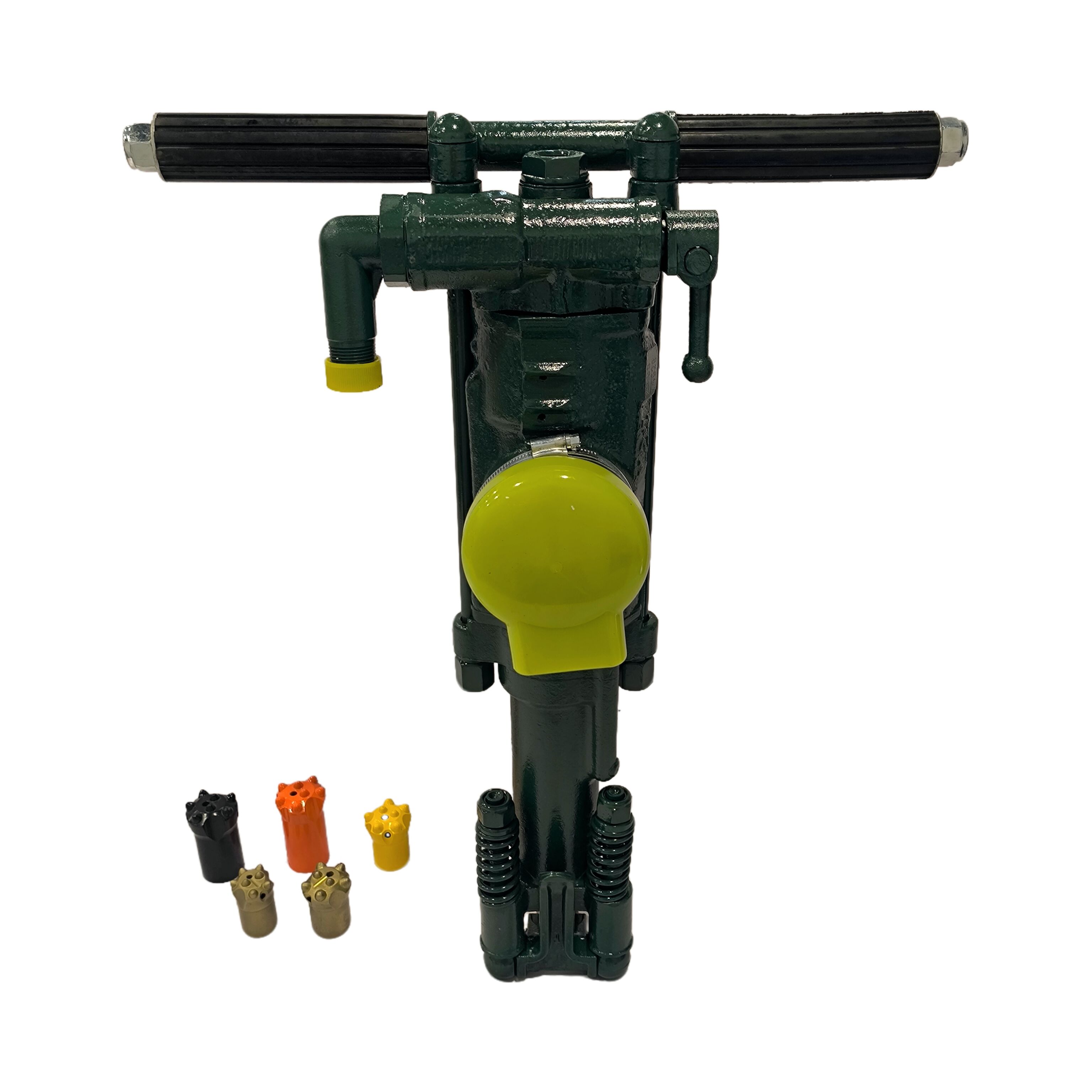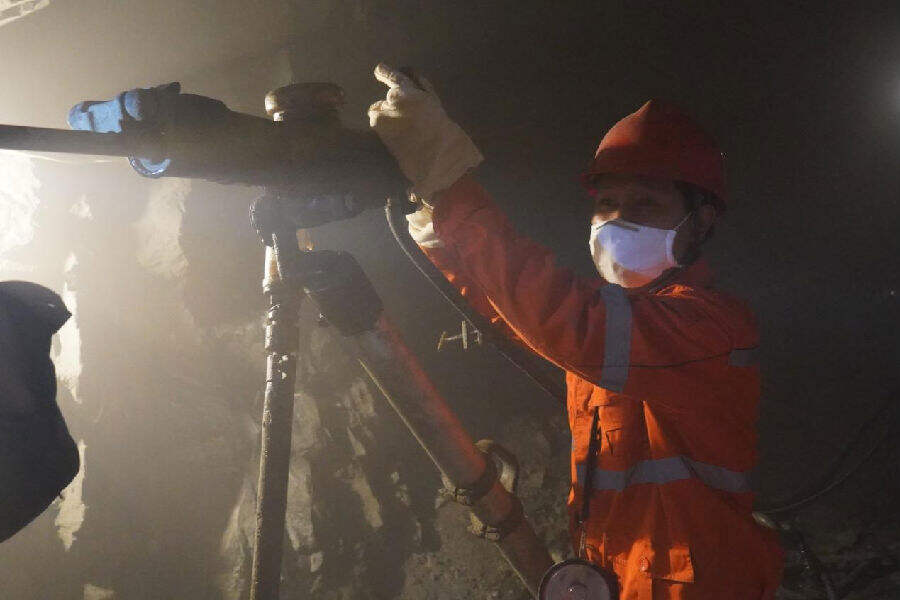Արտադրության գործընթացներ. Ինչպես են ստեղծվում կոփված և լցված գերանդի հարվածային ռոտացիոն բարձրակարգ սեղմման փորակները
Կոփված գերանդի հարվածային ռոտացիոն բարձրակարգ սեղմման փորակներ. Վերահսկվող դեֆորմացիա խտության և ամրության բարձրացման համար
Գերավոր հանգիտնաբաններ այս մեքենաները շատ ավելի երկար են տևում, քանի որ դրանք ձևավորվում են տաք մետաղական կտորներից՝ օգտագործելով բարձր ճնշում: Այս մեքենաները աշխատում են հիդրավլիկ սեղմիչների միջոցով, որոնք տատանվում են 5000-ից մինչև 25000 տոննա, և սեղմում են մետաղական հատիկները շատ խիտ: 2023 թվականի վերջերս հրապարակված մեկ ուսումնասիրությունն էլ ցույց տվեց մի հետաքրքիր փաստ. երբ վերահսկում ենք մետաղի դեֆորմացիան կովկացման ընթացքում, ներքին փոքր օդային պարկերը նվազում են մոտ երեք քառորդով ձուլման մեթոդի համեմատ: Սա արդյունքում առաջացնում է 7,85 գ/սմ³-ից բարձր խտություն համաձուլվածքային պողպատե մասերի համար: Ինչ է նշանակում սա: Մետաղի անընդհատ հոսքը կովկացման գործընթացի ընթացքում իրականում այս գործիքներին շատ ավելի լավ դարձնում է կրկնվող լարվածություններ կրելու մեջ: Սա շատ կարևոր է, քանի որ շատ արտադրանքներ օպերացիայի ընթացքում յուրաքանչյուր վայրկյան հարվածվում են հիսունից մինչև հարյուր անգամ:
Ձուլված ժայռային արտադրիչներ. Կարողանում են լցվել մոլտեն մետաղով ձևափորերի մեջ և դրանց սահմանափակումները
Գոտկավորման գործընթացը հիմնականում նշանակում է կարողատաք մետաղի լցում ավազե կամ կերամիկական կաղապարների մեջ: Սա հնարավորություն է տալիս ստեղծել շատ բարդ ձևեր, սակայն որոշ կառուցվածքային խնդիրներ էլ բերում է իր հետ: Նյութերի գիտության վերջերս հրապարակված ուսումնասիրությունների համաձայն՝ անցյալ տարի, մեծ մասամբ թափանցիկ փորվածքներ ունեցող ապրանքների 5-ից մինչև 15 տոկոսն են կազմում: Սրանք մետաղի ներսում գտնվող փոքրիկ օդային պարկեր են, որոնք լարվածության դեպքում ճեղքերի առաջացման սկզբնակետ են դառնում: Թափանցիկ մասերը բավարար լավ են աշխատում այն ավելի թեթև գործիքների համար, որոնք բարդ դիզայն են պահանջում, սակայն հարվածների դիմադրության տեսանկյունից դրանք այնքան էլ լավ չեն աշխատում, ինչպես կովկավորվածները: ASTM E23 Charpy մեթոդներով կատարված փորձարկումները ցույց են տվել, որ թափանցիկ մասերն իրենց կովկավորված համակիցների համեմատ հարվածի դիմադրությունն ունեն մոտ 32%: Որոշ առաջադեմ մտածողություն ունեցող ձուլարաններ հիմա կիրառում են թափանցման հետևանքով հատուկ մշակումներ, ինչպիսին է տաք իզոստատիկ սեղմումը, որը օգնում է նվազեցնել այդ թերությունները: Այնուամենայնիվ, այս լրացուցիչ քայլերը անշուշտ ավելացնում են արտադրության արժեքը, որը 18-ից 25 տոկոսով ավելի բարձր է:

Արտադրության մեթոդների և նյութական հետևողականության հիմնական տարբերությունները
| Հատկություն |
Դրսևառված բարձ |
Գոտված բարձ |
| Հյուսվածքի կառուցվածք |
Ուղղորդված, հարթ |
Պատահական, փռված |
| Բացասական հաճախադեպություն |
<0,5% խառնուրդ |
3-8% ծկման առկայություն |
| Արտադրության թույլատվություն |
±0.2 մմ |
±1.5 մմ |
| Գնահատվածային արդյունավետություն |
Բարձր սկզբնական, ցածր շարունակական |
Ցածր սկզբնական, բարձր փոխարինման |
Խողովակավորման սեղմողական ուժերը ստեղծում են համապատասխան մետաղական հոսքային գծեր, որոնք հետևում են ֆրեզայի կոնտուրներին, իսկ լիցքավորման պնդացումը հանգեցնում է անկանոն հատիկային սահմանների: Այս տարբերություններն են բացատրում, որ խողովակավորված մասերը 2–3 անգամ ավելի երկար են տևում գրանիտի հանքարդյունաբերության մեջ՝ մինչև փոխարինման կարիք ունենալը:
Խողովակավորված և լիցքավորված ֆրեզաների միկրոկառուցվածքային ամբողջականությունը և նյութի սխալները
Խողովակավորված ֆրեզաների հատիկային կառուցվածքի համակենտրոնությունը բարձր ճնշման տակ
Խողովակավորման ընթացքում՝ 1200 °C-ից բարձր ջերմաստիճաններում, պողպատե բիլետները սեղմվում են չափազանց բարձր ճնշման տակ, ինչը հատիկների հարթակները կազմում է անընդհատ ուղղորդված օրինաչափություններ: Այս միաուղղության հատիկային հոսքը 42 %-ով կրճատում է լարվածության կենտրոնացման կետերը համեմատած լիցքավորված անալոգների հետ ( Հարավարևմտյան պողպատի մշակման գործընթաց, 2023 ), որը բարելավում է կառուցվածքային համասեռությունը և հարվածային դիմադրությունը:
Պատահական հատիկների առաջացում և ծակոտկեղություն լցակավի պտուտակներում
Լցման ընթացքում մետաղը սառչում է անհավասարաչափ, ինչի արդյունքում՝
- Իզոտրոպ հատիկների առաջացում՝ առանց ուղղորդված հարթակման
- Մակերեսային ծակոտկեղություն՝ ստանդարտ ձուլման դեպքում միջինը 3–5%
- Ներքին միկրոխոռոչներ, որոնք նվազեցնում են բեռնակրությունը 18–26%-ով
Այս ներքին թերությունները մեծացնում են ճեղքերի տարածման հավանականությունը ցիկլային լարվածության տակ, նույնիսկ եթե արժեքի առումով առավելությունները ձուլած պտուտակներին հատուկ դարձնում են բարդ կոնստրուկցիաների համար
Տարածված թերություններ՝ խառնուրդներ, ծալքեր և խոռոչներ ձուլած նյութերում
| Աղավաղման տեսակ |
Տարածվածություն ձուլման մեջ |
Ազդեցությունը պտուտակի աշխատանքի վրա |
| Գազային ծակոտկեղություն |
մերժված մասերի 34% |
Կրճատում է հարվածային կայունությունը 22%-ով |
| Ավազի ներառումներ |
19% |
Ստեղծում է լարվածության կենտրոններ փողի խողովակներում |
| Սեղմման խոռոչներ |
28% |
Նվազեցնում է պտտման դիմացկայությունը |
Չնայած ժամանակակից Ռենտգենյան ստուգման համակարգերը հայտնաբերում են կրիտիկական թերությունների 92%-ը մշակման նախապատրաստման ընթացքում, սակայն դրանց վերացումը պահանջում է թանկարժեք հավելյալ գործընթացներ, որոնք հազվադեպ են արդարացվում անցքեր փորելու մասերի համար: Դանակները՝ դեֆորմացիայի միջոցով ստացված մետաղից, ամբողջովին խուսափում են այս խնդիրներից՝ միասնական կառուցվածք ունենալու շնորհիվ:
Ամրություն և երկարակեցություն. Լարվածության, հարվածային և շահագործման կայունություն
Կոփված և լցված մետաղների ձգման և շահագործման ամրության համեմատություն
Կոփման միջոցով պատրաստված քարի ֆրեզերային գործիքներն ունեն մոտ 15-ից մինչև 30 տոկոսով ավելի մեծ ձգման ամրություն, քանի որ մետաղի շերտերը ճիշտ են դասավորվում այս գործընթացի ընթացքում, և դրանց միջև առկա է ավելի քիչ դատարկ տարածություն: Երբ այս գործիքները ենթարկվում են կրկնվող լարվածության՝ ինչպես դա տեղի է ունենում շինարարական հրապարակներում օրերի ընթացքում, դրանք մոտ երկու անգամ ավելի երկար են ծառայում, քան այլ տեսակները, մինչև մաշվածության նշաններ ցուցադրելը: Նյութերի փորձարկումները հաստատում են սա՝ ցուցադրելով միլիոնավոր օգտագործման ցիկլներից հետո առկա էական տարբերություններ: Կոփման գործընթացն առաջացնում է ներքին լարվածության կետեր, որոնք իրականում կանխում են փոքր ճեղքերի առաջացումը: Լցված ֆրեզերային գործիքները չեն օգտվում այս պաշտպանությունից, քանի որ նրանց շերտավոր կառուցվածքները ամբողջովին անկանոն են, ինչը նշանակում է, որ փոքր ճեղքերը շատ ավելի արագ են տարածվում՝ ենթարկվելով ստիպողական ճնշման:
Բարձր կոպտություն և հարվածային բեռի դիմադրություն անցքա drilling գործողություններում
Դիտարկելով հարվածային փորման գործընթացը՝ կովաշած մասերը կարող են դիմակայել մոտ 40-ից 60 տոկոսով ավելի մեծ էներգիայի, քան մինչև դրանց քայքայվելը: Ինչո՞ւ: Կովաշած նյութերն ունեն ամբողջական ներքին կառուցվածք, որը հավասարաչափ բաշխում է հարվածային ուժերը՝ օգտագործելով կազմակերպված հատիկների ձևավորումները: Փորձարկման արդյունքները ցույց են տալիս, թե որքան մեծ է այս տարբերությունը: Սովորաբար մանրադիտակային ճեղքերի առաջացման վայրերում առկա են փոքր օդային պոկոտներ (թափանցիկություն) և այլ խառնուրդներ, որոնք հաճախ հանդես են գալիս որպես ճեղքերի առաջացման կենտրոններ: Փորձարկումները ցույց են տալիս, թե որքան մեծ է այս տարբերությունը: Գոյացված գործիքները սովորաբար կոտրվում են մոտ 18 Ջոուլ կամ քառակուսի սանտիմետր հարվածային էներգիայի դեպքում, իսկ կովաշած գործիքները դիմակայում են մինչև մոտ 28 Ջոուլ քառակուսի սանտիմետր: Սա մեծ նշանակություն ունի այն դեպքերում, երբ աշխատում ենք դժվար քարով ձևավորված շերտերում, որտեղ հանկարծակի հարվածները ամենօրյա գործողությունների մաս են կազմում:
Իրական աշխարհի մաշվածություն՝ բարձր լարվածության միջավայրերում անհաջողության դեպքեր
2023 թվականին հանքերից հավաքված տվյալները ցույց են տալիս, որ մետաղաձուլված ժայռապատռիչները պետք է փոխարինվեն մոտ 2,3 անգամ ավելի հաճախ, քան դրանց կովկավորված համակարգը՝ գրանիտի միջով աշխատելիս: Կովկավորման գործընթացը մետաղի մակերևույթին սեղմողական լարվածություն է ստեղծում, որը օգնում է կանխել այդ անհանգստացնող փոսերի և ճեղքերի առաջացումը, այդպիսով՝ կովկավորված պատռիչները մոտ 65 տոկոսով ավելի երկար են պահպանում իրենց սուր եզրերը քվարցիտի դեմ պայքարում: Այնուամենայնիվ, նշելի է, որ մետաղաձուլված պատռիչները կարող են բավարար աշխատանք տալ կարճատև աշխատանքների դեպքում՝ փափուկ նստվածքային հանքապարներում, որտեղ կարևոր է առաջին հերթին գումար խնայելը, քան այն, թե որքան երկար կաշխատեն դրանք մինչև փոխարինման կարիք ունենալը:
Գործարար կիրառություններում կյանքի տևողությունը և երկարաժամկետ արժեքը
Կովկավորված և մետաղաձուլված ժայռապատռիչների մաշվածությունը չափավոր և ծանր օգտագործման դեպքում
Քարի ֆորսները, որոնք պատրաստվում են կովկայման միջոցով, կարող են երեքից հինգ անգամ ավելի երկար ծառայել, քան լիցքավորված նմանակները, հատկապես այնպիսի դժվար պայմաններում, ինչպիսիք են հանքարդյունաբերության մեջ, ինչպես պարզվել է ASTM International-ի 2023 թվականի վերջերս հրապարակված զեկույցում, որտեղ ուսումնասիրվում էր արդյունաբերական ֆորսների կյանքի տևողությունը: Ինչո՞ւ: Կովկայված գործիքներն ունեն խիտ կառուցվածք, որը կանխում է փոքր ճեղքերի տարածումը՝ կրկնվող հարվածների դեպքում, ինչը շատ կարևոր է այն հանքերի համար, որտեղ աշխատանքները օրական 8 ժամից ավել են տևում: Ընդ որում, լիցքավորված մասերը պարզապես այդքան հարմար չեն լինում այդպիսի ծանր պայմանների համար: Գործնականում տեսել ենք, որ դրանք ավելի շուտ են ձախողվում, հատկապես գրանիտի հանքավայրերում, որտեղ ձախողման դեպքերի քանակը տասներկու ամսվա ընթացքում աճում է 20%-ից 40% միջակայքում՝ հաստատված անընդհատ օգտագործման դեպքում, ըստ միջազգային հրապարակման՝ Անցքա drilling ինժեներիայի միջազգային ամսագրում:
Արժեք ընդդեմ Տևականություն. Կովկայված մասերի տնտեսական առավելությունները ժամանակի ընթացքում
Չնայած 50–70% ավելի բարձր սկզբնական արժեքին՝ կովկայված ֆորսները ավելի բարձր են գնահատվում կյանքի ամբողջ տևողության ընթացքում.
| Ծախսերի գործոն |
Դրսևառված բարձ |
Գոտված բարձ |
| Սկզբնական գնում |
$12,000–$18,000 |
$5,000–$7,500 |
| Տարեկան փոխարինումներ |
0.3 միավոր |
1.8 միավոր |
| Կանգնեցման ծախսեր/տարի |
$4,200 |
$25,000 |
| ընդհանուր ծախս 5 տարվա ընթացքում |
$78,000 |
$142,500 |
Այս մոդելը համապատասխանում է կյանքի ցիկլի ծախսերի վերլուծության ուսումնասիրության -ի արդյունքներին՝ ցույց տալով, որ կովաղած գործիքները շահագործման ընթացքում 18–24 ամսում հասնում են ծախսերի հավասարման:
Երբ մանրաթել փորվածքները ապահովում են բավարար կատարում՝ ցածր արժեքով
Լիցքային գործիքները բավականին լավ են աշխատում այն աշխատանքների համար, որոնք տևում են վեց ամսից պակաս կամ երբ գործ են ունենում Մոհսի 5-րդ կամ նրանից ցածր կոշտության աստիճանի փափուկ ժայռերի հետ: Նրանք նաև փոխանակուղիների համեմատ սկզբնական ծախսերը կրճատում են մոտ մեկ երրորդից մինչև երկու երրորդ: Ինչպես տեսել ենք որոշ երկրաբանական ուսումնասիրություններում, այս գործիքները կարող են 7000-ից մինչև 10000 հարված դիմանալ ավազաքարում՝ մինչև մաշվելը, ինչը նրանց մոտեցնում է այն, ինչ ձողային գործիքները ցուցադրում են նմանատիպ պայմաններում՝ համաձայն անցյալ տարվա «Mining Equipment Quarterly» հրատարակության: Այս համակարգերի սպասարկման համար պատասխանատու անձնակազմի համար խելամիտ կլինի ստուգել լիցքային մասերը մոտավորապես յուրաքանչյուր գործարկման ժամանակի քառորդից հետո՝ այն նյութերի քայքայման նշանների համար, որոնք կարող են առաջանալ կապտավուն կառուցվածքի պատճառով: Սա օգնում է պահպանել համակարգի հուսալի աշխատանքը՝ միաժամանակ հաշվի առնելով ծախսերի և աշխատողների անվտանգության հարցերը:
Ճիշտ պտուտակի ընտրություն. համապատասխանեցնելով ձողավոր կամ լիցքավորված տարբերակները կիրառման պահանջներին
Խորհուրդ տրվող կիրառման դեպքեր ձողավոր ժայռապոկոցների համար հանքարդյունաբերության և խորը պտտման համար
Ձուլման միջոցով պատրաստված ժայռային հեղուկները շատ լավ են աշխատում ստորգետնյա հանքերում և խորը հորերում հանդիպող բարդ պայմաններում: Այս գործընթացի ընթացքում մետաղական հատիկների դասավորության ձևը, երբ նյութը դեֆորմացվում է բարձր ճնշման տակ, ըստ 2023 թվականի արդյունաբերական ուսումնասիրությունների, այս գործիքներին տալիս է մոտ 18% ավելի լավ մաշվածության դիմադրություն՝ համեմատած ձուլածո տարբերակների հետ: Այն գործողությունների համար, որոնք անընդհատ աշխատում են գրանիտի կամ քվարցիտի նման դժվար ժայռերի դեմ, որտեղ լարվածության ցիկլերը հաճախ գերազանցում են 50 ՄՊա-ն, կովկացված հեղուկները փոխարինման միջև ավելի երկար են դիմանում: Շատ հեղուկների օպերատորներ կասեն, որ այս տարբերությունը շատ մեծ նշանակություն ունի, երբ ամեն օր աշխատում են այդպիսի բարդ պայմաններում:
Դեպքեր, երբ ձուլած ժայռային հեղուկները ավելի տնտեսապես շահավետ ընտրություն են
Այն անձանց համար, ովքեր աշխատում են նստվածքային ժայռերի շերտերում՝ կողպված ժայռագործ մեքենաները հաճախ դառնում են նախընտրելի տարբերակ: Դրանք մի փոքր թույլ են 23 տոկոսով ազդեցության ուժով համեմատած այլ տեսակների հետ, սակայն իրենց ամրության պակասը հատուցվում է ճկունությամբ: Ձուլման գործընթացը հնարավորություն է տալիս արագ կերպով կատարել կարգաբերումներ՝ հարմարեցնելով տարբեր ժայռային պայմանների, ինչը հատկապես օգտակար է այնպիսի ձևավորումների հետ աշխատելիս, ինչպիսիք են կրաքարի շերտերը կամ սիլիցիումի աղերը: Շատ մարդիկ, ովքեր հետևում են իրենց ծախսերին, ընտրում են այս կողպված մոդելները՝ հետախուզական աշխատանքների կամ շինարարության համար, երբ ընդհանուր աշխատանքային ժամանակը չի գերազանցում մոտ 100 ժամը: Տնտեսապես այս ընտրությունը հիմնավորված է, քանի որ աշխատանքը չի տևում այնքան երկար, որ արժանի լինի ներդրում ավելի մաշվողական սարքավորումներում:
ՈՒղեցույց առերևելի և կողպված տարբերակների ընտրության համար՝ կախված շահագործման պայմաններից
Երեք հիմնական գործոններ որոշում են օպտիմալ ընտրությունը.
-
Ժայռի կարծրություն : Առերևելի մույթերը ավելի լավ են աշխատում Մոհսի 6+ երկրաբանական շերտերում
-
Նախագծի մասշտաբ : Կողպված տարբերակները նվազեցնում են սկզբնական ծախսերը 37%-ով՝ երկու շաբաթից պակաս տևողությամբ նախագծերի համար
-
Շատերի հաճախադեպություն : Դարձված մասերը դիմանում են 12% բարձր գագաթնային հարվածային ուժերի
Ինչպես նշված է համապարփակ նյութերի ուսումնասիրություններում , դարձված գործիքները ավելի մեծ ROI են ապահովում բարձր հարվածային և երկարաժամկետ գործողությունների դեպքում՝ չնայած ավելի բարձր սկզբնական ներդրմանը: Լիցքավորման լուծումները մնում են հարմար ընդհատվող օգտագործման համար չափավոր լարվածության պայմաններում, որտեղ արագ փոխարինումը հատված է դարձնում մաշվածության սահմանափակումները:
Հաճախ տրամադրվող հարցեր
Որո՞նք են դարձված ժայռապոկոցների առավելությունները լիցքավորված ժայռապոկոցների նկատմամբ:
Դարձված ժայռապոկոցները ավելի մաշվածակայուն են և ավելի բարձր ձգման ամրություն ունեն՝ դրանց ուղղորդված հատիկավոր կառուցվածքի շնորհիվ, ինչը դրանք ավելի հարմար է դարձնում բարձր հարվածային և երկարաժամկետ գործողությունների համար: Նրանք սովորաբար ավելի երկար են տևում, քան լիցքավորված ժայռապոկոցները, և ավելի լավ են դիմանում կրկնվող լարվածությանը՝ ապահովելով ավելի երկար կյանքի տևողություն:
Ինչո՞ւ մարդիկ կարող են ընտրել լիցքավորված ժայռապոկոցներ
Խոտանի բարդիչները, որպես կանոն, ընտրվում են կարճաժամկետ նախագծերի համար կամ այն դեպքերում, երբ աշխատում են փափուկ ժայռերի հետ, քանի որ նվազեցնում են սկզբնական ծախսերը և առաջարկում են բարդ դիզայնի հնարավորություններ՝ պայմանավորված լիցքավորման գործընթացով: Դրանք տնտեսապես շահավետ են այն նախագծերի համար, որոնք օգտագործվում են ավելի հազվադեպ կամ ավելի ցածր հարվածային բեռնվածության դեպքում:
Ինչպե՞ս են համեմատվում կովաշած և խոտանի բարդիչները ծախսերի և ծառայողական կյանքի տեսանկյունից:
Կովաշած բարդիչներն ունեն ավելի բարձր սկզբնական արժեք, սակայն հաճախ ավելի լավ երկարաժամկետ արժեք են ապահովում՝ իրենց տևականության և փոխարինման հաճախադեպության նվազեցման շնորհիվ: Խոտանի բարդիչները, չնայած սկզբում ավելի էժան են, կարող են ավելի բարձր ծախսեր ներառել փոխարինման և կանգնելու ժամանակի համար՝ հատկապես բարձր լարվածության պայմաններում:


